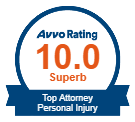.jpeg) According to the Insurance Information Institute (III), more than ten percent of motorists in Virginia drive with no liability insurance, and many drivers who are insured carry only the minimum coverage limits required by law. This means that you could be involved in an accident caused by a motorist who does not have sufficient insurance coverage to pay your damages, which include medical expenses, property damage, lost income, and pain and suffering that result from the crash.
According to the Insurance Information Institute (III), more than ten percent of motorists in Virginia drive with no liability insurance, and many drivers who are insured carry only the minimum coverage limits required by law. This means that you could be involved in an accident caused by a motorist who does not have sufficient insurance coverage to pay your damages, which include medical expenses, property damage, lost income, and pain and suffering that result from the crash.
You might also be the victim of a wreck caused by a stolen car, an uninsured farm vehicle that’s out on the road, or a vehicle being used without the owner’s permission. For these reasons, your own liability insurance policy includes coverage for damages caused by uninsured (UM) or underinsured (UIM) drivers. This coverage, which you receive automatically unless you waive it, allows you to file a damage claim with your own insurance company. After your insurer pays your claim, it will take legal action to recoup its money from the uninsured or underinsured driver who caused the crash.
Virginia’s UM and UIM Coverage Prior to July 2023
In the past, if you were involved in a wreck caused by an underinsured motorist, your insurer could essentially reduce your amount of UIM coverage by taking a “credit” against your coverage in the amount of the liability coverage carried by the underinsured driver. For example, your crash might have been caused by an underinsured motorist who had only the minimum coverage limits of $30,000 per person and $60,000 per accident (30/60 coverage).
If your UIM coverage had limits of $50,000 per person and $100,000 per accident (50/100 coverage), your insurer could use the at-fault driver’s 30/60 as a credit against your 50/100 coverage, which would then be reduced to 20/40 coverage. In other words, you would get a maximum of only 50/100 to cover your damages. You were not permitted to “stack” the two policies to get 80/160 coverage. If your damages amounted to more than $50,000, you would be left owing a balance that your insurer was not required to pay.
Virginia’s UM and UIM Coverage After July 2023
Under the law that went into effect in July 2023, you are permitted to stack your policy’s UIM coverage limits and the liability coverage of the underinsured driver who causes your accident. Referring again to the example above, you would then have 80/160 coverage available to you if your damage claim is an expensive one.
It’s important to remember, however, that all insurance companies are for-profit businesses that exist to earn money for their shareholders. Not only the at-fault driver’s insurer but also your own could become an adversary and try to dispute, devalue, or deny your UIM claim. In such a case, you’re well advised to consult an experienced car accident attorney from Dulaney, Lauer & Thomas to help you seek fair compensation for your damages.
Should You Opt Out of UM/UIM Coverage?
Any policy that is issued or renewed in Virginia after July 1, 2023, will include UIM coverage that can be stacked unless the policyholder chooses to opt out of UM/UIM coverage altogether. Your insurance company might actually offer you incentives to opt out because it would rather not be on the hook for high-damage claims that could cost a lot of money.
Your insurer might tell you that your monthly premiums will be reduced if you opt out of the new UM/UIM coverage. The amount of money you can save in reduced premiums, though, is comparatively small. By paying a little more each month to maintain UM/UIM coverage that can now be stacked with the at-fault driver’s liability coverage, you essentially double the amount of money available for your damages if you should be involved in a serious wreck.
Car Crash Injuries Can Be Very Costly
Victims of serious vehicle accidents, especially those in which a passenger car is hit by a commercial truck or other large vehicle, can result in catastrophic injuries:
- Fractured or crushed bones
- Eye injuries or blindness
- Lacerations, scarring, and disfigurement
- Whiplash
- Spinal cord damage
- Paralysis
- Traumatic brain injury (TBI)
Such injuries can prevent you from working for a significant period of time or for life. You also might require surgery, hospitalization, expensive long-term treatment and recovery, home nursing care, assistive equipment, physical therapy, and rehabilitation. Because the cost of such medical care can be astronomical, the coverage you gain by maintaining stackable UIM insurance is well worth the slightly increased premiums you’re likely to pay. If you don’t have sufficient coverage for your damages after a serious accident, your only recourse is to sue the at-fault driver for the balance of expenses that your insurance won’t pay. Doing so is costly, complicated, tedious, and time-consuming.







